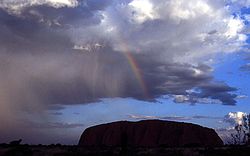
Back مكان مقدس Arabic Святыя месцы Byelorussian Свято място Bulgarian Holy place English Lugar sagrado Spanish Pühapaik Estonian Hillich plak Frisian 聖地 Japanese 성지 Korean Heilige plaats Dutch

A sacred site is a place that is thought of as sacred (or holy) to a particular religion. Every one of the world's major religions has sacred sites. Some religions, such as Islam, Hinduism, and Christianity think of the sacred sites as being very important to their faith. In other religions such as Protestant Christianity, sacred sites are not so important.
The idea that a place is sacred often comes from something that has happened at the place, or a religious story about that place. Mount Sinai is a sacred site for Jews and Christians because it was on Mount Sinai that Moses received the Ten Commandments of God.
The sacred site might be a natural site, or it might be a building of some sort. One of the most famous natural sites that is also a sacred site is Uluru (also called Ayre's Rock) in Central Australia. It is believed to have been sacred to the aboriginal people for about 40,000 years. Other famous natural sites are the sacred trees of India, Japan and South East Asia.
Very often, buildings have been made on natural sites that were already thought of as sacred. For example, a spring of water coming from the ground might be said to have healing powers. A special well-house might be built around the spring to protect it, and as a place where people might leave offerings (gifts to a god).
Other sites are thought of as sacred because a holy person or saint lived there, or died there, or their body is kept there. The Church of the Holy Sepulchre in Jerusalem is one of the most sacred sites to Christianity because it is believed that Jesus' body was placed in a tomb there. The city of Mecca is sacred to all Muslim people as the birthplace of the prophet Muhammad.
© MMXXIII Rich X Search. We shall prevail. All rights reserved. Rich X Search